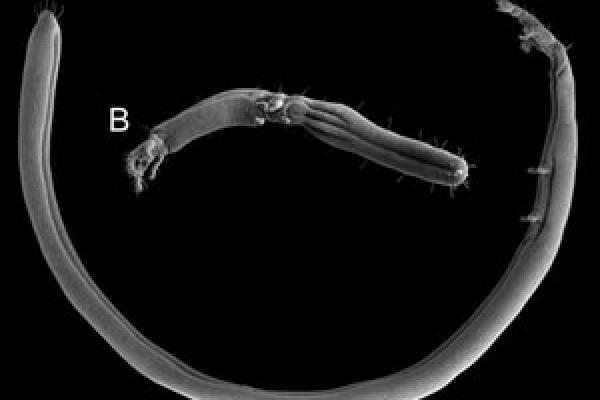Publications by EEOB faculty November 1- November 12

Source: USDA, public domain
The role of the integument with respect to different modes of locomotion in the Nematalycidae (Endeostigmata)
Bolton SJ, Bauchan GR, Ochoa R, Pooley C, Klompen H. 2014. Experimental and Applied Acarology. DOI 10.1007/s10493-014-9857-0
Abstract
Previous research on the locomotion of the Nematalycidae has only been undertaken on Gordialycus, which is by far the most elongated genus of the family. Gordialycus is dependent on an unusual form of peristalsis to move around. It was not known whether the genera of Nematalycidae with shorter bodies also used this mode of locomotion. Our videographic recordings of Osperalycus did not reveal peristalsis. Instead, this mite appears to move around the mineral regolith via the expansion and constriction of the metapodosomal and genital region, allowing greater versatility in the way that the annular regions contract and extend. This type of locomotion would enable relatively short bodied nematalycids to anchor themselves into secure positions before extending their anterior regions through tight spaces. Low-temperature scanning electron micrographs show that the short bodied genera have integumental features that appear to be associated with this mode of locomotion. Peristalsis is almost certainly a more derived form of locomotion that is an adaptation to the unusually long body form of Gordialycus.
Acarology Lab
Mulch Effects on Floral Resources and Fruit Production of Squash, and on Pollination and Nesting by Squash Bees
Caitlin E. Splawski, Emilie E. Regnier, S. Kent Harrison, Karen Goodell, Mark A. Bennett and James D. Metzger. 2014. HortTechnology. 24,5: 535-545
Abstract
Zucchini squash (Cucurbita pepo) has a high pollination demand, and the native, ground-nesting squash bee (Peponapis pruinosa) provides the majority of the crop’s pollination requirement in some environments. Squash bees nest directly in crop fields, and nests can be disturbed by tillage and other management operations. Mulches that use municipal waste materials may provide a weed control strategy for squash plantings that is more benign to squash bees than cultivation. Field and greenhouse studies were conducted in 2011 and 2012 to compare the effects of nontillage weed control methods including polyethylene black plastic, woodchips, shredded newspaper, a combination of shredded newspaper plus grass clippings (NP + grass), and bare soil (control) on soil characteristics, squash pollination and fruit production, and squash bee nesting. Woodchips, shredded newspaper, and NP + grass mulch decreased soil temperature, while soils beneath newspaper mulch retained more moisture. Unmarketable, misshapen fruit occurred more frequently in plastic than in the other mulch treatments. No measurable differences in floral resource production or crop pollination were found among treatments, suggesting that misshapen fruit resulted from high soil temperatures in black plastic plots rather than poor pollinator attraction. Squash bee nests were located within bare soil, newspaper, and NP + grass plots, indicating that these mulches did not prevent nesting. NP + grass mulch had a positive effect on plant growth and fruit production, possibly from an addition of plant-available nitrogen or the presence of preferable nesting ground. Shredded newspaper when combined with grass clippings performed as an effective mulch material that improved crop performance with no apparent negative impacts on squash bee nesting or on squash floral resources and pollination.
Goodell Lab
